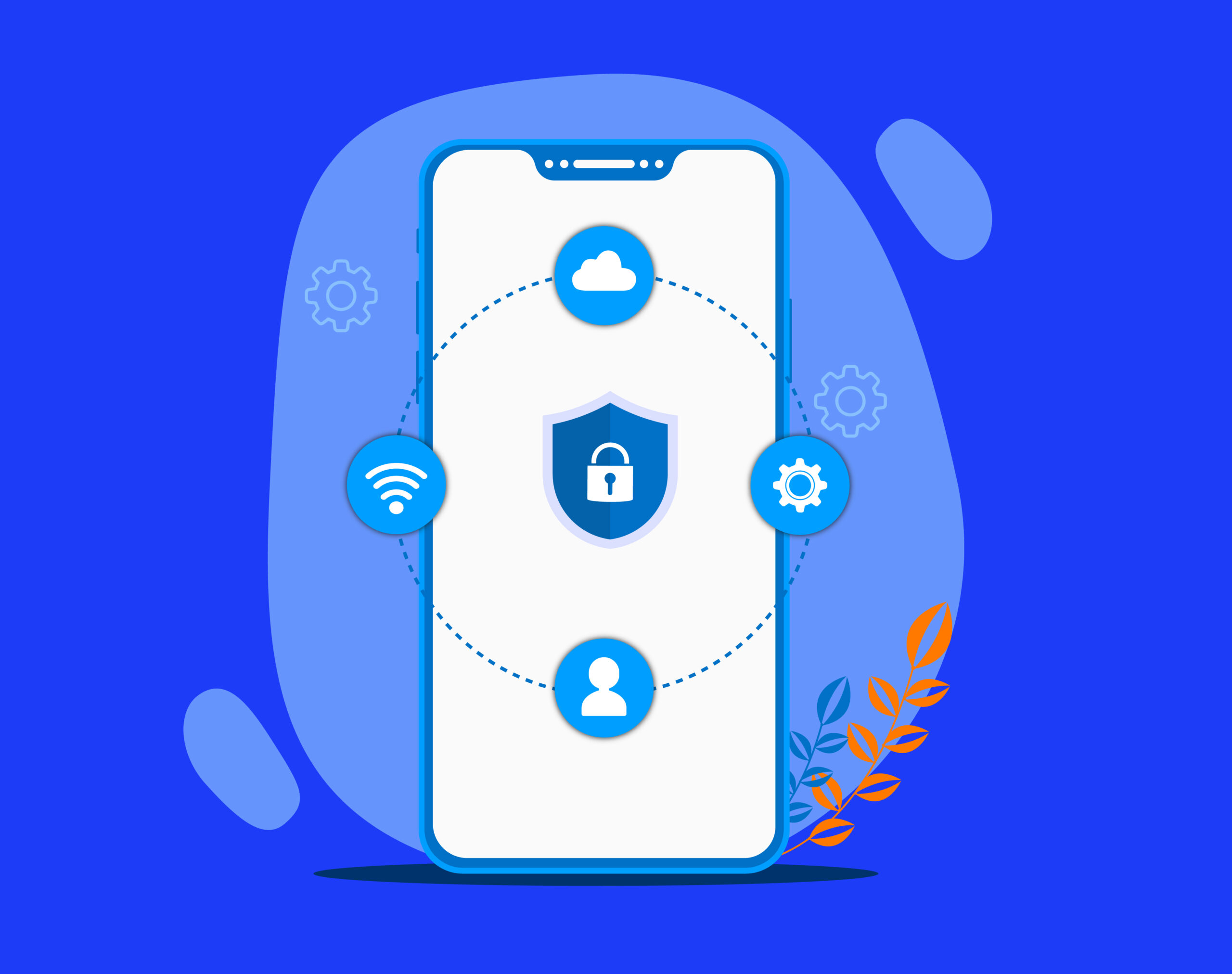Mobile app security goes beyond just a technical term. It protects your data, your privacy, and your peace of mind. Without it, you’re exposed to a world of digital threats. According to the research, at least one security flaw exists in more than 75% of all published apps.
Have you ever wondered how safe your favorite apps really are or why some apps ask for so many permissions? The answer is mobile app security.
Are you prepared to take charge of your online life? Let’s explore mobile app security, its types, common risks, and best practices for protecting your data from cyber-attacks.
What is Mobile App Security?
Mobile app security is a set of measures that protects your apps and data from cyber threats, data breaches, and malicious attacks. Many strategies and technologies are utilized to protect mobile apps from malicious attacks, unauthorized access, data breaches, and other security risks.
Mobile app security isn’t just one thing. It’s a combination of strategies. These include:
- Encryption: It scrambles your data. Only authorized users can unscramble it.
- Authentication: It verifies user identity. Passwords, fingerprints, or face scans are common methods.
- Authorization: It controls what users can access within an app.
- Secure coding: Developers build security into the app’s DNA.
- Regular updates: They patch vulnerabilities and strengthen defenses.
Without mobile app security, your data is at risk. Hackers can steal your identity. They can access your bank accounts. They can even spy on your personal life.
But with strong security, you’re protected. Your data stays private, and your personal information remains secure. You can use your apps with confidence.
5 Most Common Mobile App Security Risks
Even with security measures, risks persist. Here are the top five threats to mobile app security:
1. Data Leakage
Apps can unintentionally expose sensitive data through poor encryption or insecure data storage, and your personal information could fall into the wrong hands. Examples include unencrypted data stored in the local file system, SQLite databases, shared preferences, or keychains.
2. Insecure Communication
Many apps transmit data over networks. If not properly secured, this data is vulnerable to hackers, who can intercept and steal information. For example, unencrypted communication channels such as HTTP are used instead of HTTPS.
3. Weak Authentication
Simple passwords are easy to crack, and the lack of multi-factor authentication is a significant risk. It’s like leaving your front door unlocked. Weak authentication mechanisms can allow unauthorized users to access the application and its data.
4. Reverse Engineering
Hackers can decompile and analyze app code, find vulnerabilities, or steal intellectual property. It’s like giving thieves your house blueprints.
5. Malware
Malicious software can infect apps, steal data, or take control of your device. It’s a digital parasite feeding on your personal information.
Types of Mobile App Security
Mobile app security comes in various flavors. Each type targets specific vulnerabilities. Let’s explore the main categories:
- Network Security
- Data Security
- Authentication and Authorization
- Data Security
- Code Security
- Platform Security
- API Security
Network Security:
This protects data in transit and secures communication between your app and servers. Protocols like HTTPS and SSL/TLS encrypt data during transmission. Virtual Private Networks (VPNs) can also be utilized to create secure connections, especially on public Wi-Fi.
It also includes Implementing firewall rules to control incoming and outgoing network traffic based on security policies.
Data Security:
It makes sure that data stored on the device is protected. It can be done in two ways:
- Encrypting sensitive data stored locally on the device.
- Using secure containers or keychain services provided by the OS to store sensitive information.
Authentication and Authorization:
This verifies user identity. It controls access to app features. Methods include:
- Multi-Factor Authentication (MFA): Requiring multiple verification forms to grant access.
- OAuth and OpenID Connect: Implementing industry-standard protocols for secure authorization and authentication.
- Role-Based Access Control (RBAC): Restricting access based on the user’s role within the application.
Device Security:
This protects the physical device. It includes features like remote wipe and device lockdown. Biometric Authentication uses fingerprints, facial recognition, etc., to secure the device. Remote wipe and lock allow users to remotely lock or erase data on a lost or stolen device.
Code Security:
This focuses on the app’s source code. It involves making the code difficult to read and understand to protect against reverse engineering (Code Obfuscation). Static Code Analysis analyzes the source code for potential vulnerabilities without executing the code. Dynamic code analysis tests the application in a runtime environment to identify vulnerabilities.
Platform Security:
This utilizes built-in OS security features, including sandboxing and permission management. Sandboxing means running applications in isolated environments to prevent them from affecting each other or the system.
Secure boot practices make sure that the device boots using only trusted software. Whereas app permission management carefully manages and restricts the permissions granted to applications.
API Security:
This secures communication with the back-end servers. It involves using gateways to manage, monitor, and secure API traffic. Rate limiting and throttling prevent API abuse by limiting the number of requests a user can make.
What are the best security practices for mobile apps?
Developers and users alike play important roles in mobile app security. Here are the best practices to follow:
For Developers:
- Secure coding: Write clean, secure code from the start. Use automated tools to detect vulnerabilities. Regular code reviews are essential.
- Data encryption: Encrypt all sensitive data. This includes data at rest and in transit. Use strong, up-to-date encryption algorithms.
- Robust authentication: Implement multi-factor authentication. Use biometrics when possible. Enforce strong password policies.
- Minimal permissions: Request only necessary permissions. Be transparent about why you need them. Users appreciate honesty.
- Regular updates: Address vulnerabilities as soon as possible. Keep the app updated with the latest security features.
- Secure APIs: Use API keys and tokens. Implement rate limiting. Validate all data from APIs.
- Tamper detection: Include mechanisms to detect app tampering. This prevents unauthorized modifications.
For Users:
- Download from official stores: Stick to Google Play or Apple App Store. Avoid third-party app stores, as they often lack security checks.
- Check app permissions: Review permissions before installing an app. Question why an app needs certain access, and don’t hesitate to deny unnecessary permissions.
- Keep apps updated: Install updates promptly. They often contain crucial security patches.
- Use strong passwords: Create unique, complex passwords for each app. Consider using a password manager.
- Enable two-factor authentication: Use it wherever available. It adds an extra layer of security.
- Be cautious on public Wi-Fi: Avoid accessing sensitive apps on public networks. Use a VPN if you must.
- Regular security audits: Review installed apps periodically. Remove those you no longer use.
Remember, no app is 100% secure. But these checks can help you make informed decisions. They reduce your risk of using vulnerable apps.
How to Check Mobile App Security?
To check if a mobile app is secure, you can follow a systematic approach that includes various testing and analysis techniques. Here are some steps and tools you can use:
1. Static Analysis
- Code Review: Manually review the source code for security vulnerabilities.
- Static Analysis Tools: Use tools like SonarQube, Fortify, or Checkmarx to scan the source code for common vulnerabilities automatically.
2. Dynamic Analysis
- Runtime Testing: Test the app while it’s running to identify vulnerabilities that occur during execution.
- Dynamic Analysis Tools: Utilize tools like Burp Suite, ZAP (Zed Attack Proxy), or AppScan to monitor and analyze the app’s behavior in real time.
3. Automated Security Scanning
- Mobile Application Security Testing (MAST) Tools: To perform comprehensive security scans, use tools like the OWASP Mobile Security Testing Guide (MSTG), MobSF (Mobile Security Framework), or QARK (Quick Android Review Kit).
- CI/CD Integration: Integrate security scanning tools into your CI/CD pipeline to ensure continuous security testing.
4. Penetration Testing
- Manual Penetration Testing: Conduct manual penetration tests to simulate real-world attacks and identify vulnerabilities that automated tools might miss.
- Penetration Testing Frameworks: Use frameworks like Metasploit, Drozer, or Frida for in-depth testing and exploitation.
5. Network Security Assessment
- Network Traffic Analysis: Monitor the network traffic to ensure that all communication is encrypted and no sensitive data is transmitted in plain text.
- Tools for Network Analysis: To capture and analyze network traffic, use tools like Wireshark, tcpdump, or Charles Proxy.
6. API Security Testing
- API Endpoint Testing: Test API endpoints for security vulnerabilities such as SQL injection, XSS, and improper authentication.
- API Testing Tools: Use tools like Postman, Insomnia, or SoapUI to test and validate API security.
7. Secure Storage Verification
- Data Storage Analysis: Check how the app stores sensitive data and ensure it uses secure storage mechanisms provided by the OS.
- Tools for Storage Analysis: Inspect the app’s file system and data storage using tools like Drozer or iExplorer.
Conclusion
In this age of technological advancement, mobile app security is essential. It’s not just a theoretical idea; it’s an essential security measure for our digital lives and personal data.
We’ve explored various aspects of mobile app security, from network protection to behavioral analysis. We’ve identified common vulnerabilities, such as data leakage and inadequate authentication. Importantly, we’ve outlined best practices for both developers and users.
We must incorporate these security measures into all of our digital interactions on a daily basis. We need to be aware of our apps, update them frequently, use strong passwords, and be cautious when granting permissions.
VisionX follows strong security measures when providing mobile app development services to its clients. Our developers stay up-to-date with the latest security measures to save user’s data against cyber attacks.


